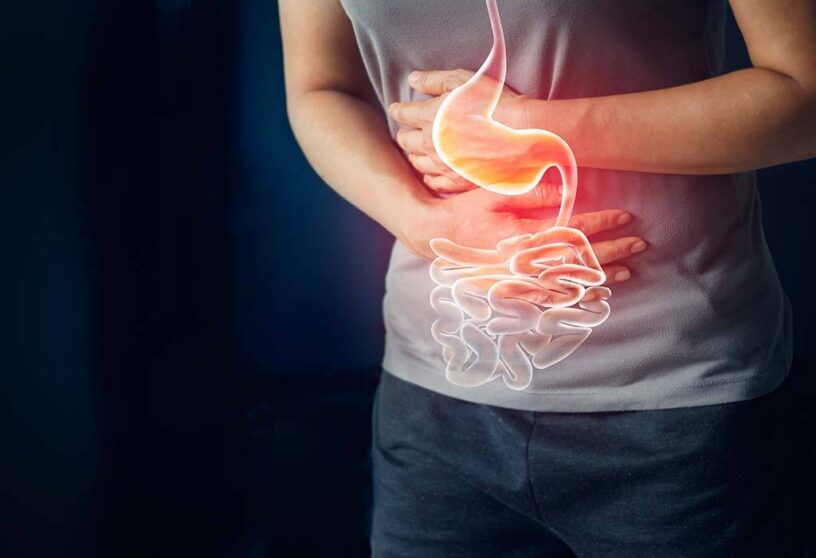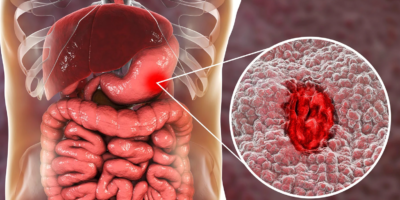Dyspepsia is another term for indigestion. Symptoms, which originate from the stomach and first part of the small intestine, include pain or burning high in the abdomen (below the tip of the breastbone), early satiety (feeling full after a few bites), feeling heaviness after eating, and belching. For many people, symptoms coincide with mealtimes. Likewise, lower GI symptoms are often associated with meals. They can include gas, bloating, and cramping. In a condition called irritable bowel syndrome (IBS), additional symptoms include diarrhea and/or constipation. The potential causes of functional bowel conditions are multiple. They include stress overload; hypersensitivity of intestinal nerves; imbalances in the bacterial ecology of the intestines; food allergies and intolerances; medications, such as nonsteroidal anti-inflammatory drugs and antibiotics; and chronic diseases, such as hypothyroidism, diabetes, anxiety, and depression.


1. Light Your Fire Salad
How it works: Herbalists have long used digestive bitters, drunk before the meal, to jump-start digestion. A European tradition is eating a salad of bitter greens after the main meal. Bitters stimulate bile and digestive enzymes.
- PREPARATION:
- 1 cup (20 g) torn arugula
- 1 cup (50 g) torn endive
- 1 cup (40 g) torn radicchio
- 2 tablespoons (30 ml) balsamic vinegar
- 1 garlic clove, minced
- Freshly ground black pepper, to taste
- ¼ cup (60 ml) olive oil
- ¼ cup (20 g) shaved Parmesan cheese
- DIRECTIONS:
Toss together the greens in a large bowl and set aside.
Pour the vinegar into a large salad bowl. Add the garlic and few sprinkles of pepper. Drizzle the olive oil into the bowl, stirring briskly with a whisk until the mixture is light brown. Empty the bowl of greens into the salad bowl with dressing. Toss. Sprinkle with the Parmesan shavings and serve immediately.
- YIELD: 4 TO 6 SERVING
2. Mango Summer Aperitif
How it works: Herbalists have long used digestive bitters, drunk before the meal, to jump-start digestion. A European tradition is eating a salad of bitter greens after the main meal. Bitters stimulate bile and digestive enzymes.
- PREPARATION:
- 2 cups (350 g) mango chunks, frozen
- ½ cup (120 ml) Muscat or Dolce dessert wine
- 1 bottle (750 ml) dry champagne, chilled
- DIRECTIONS: Partially thaw the mango chunks. Blend the mango in a blender. Add the dessert wine and blend slightly. Fill champagne flutes half-full with the mango mixture. Top with chilled champagne and serve.
- YIELD: 06 SERVING
- NOTE: Alcohol aggravates heartburn. If you have this condition, consider substituting pomegranate juice for the alcohol.
3. After-Dinner Digestive Snack
How it works: See the explanation in the previous recipe for the fennel. Also a member of the parsley family, anise has similar properties to fennel. It relieves bloating, flatulence, nausea, cramping, and poor appetite. Both seeds also freshen the breath.
- PREPARATION:
- 1 tablespoon (6 g) aniseeds
- 1 tablespoon (6 g) fennel seeds
- DIRECTIONS: Put the seeds into a small, clean jar, cap, and shake to mix. After dinner, put ¼ teaspoon of the seed mixture into the palm of your hand and pop it into your mouth. Savor the taste as you chew.
- YIELD: 24 SERVING
- NOTE: Alcohol aggravates heartburn. If you have this condition, consider substituting pomegranate juice for the alcohol.
4. Warming Digestive Tea
How it works: See previous descriptions of anise and fennel. Cardamom also relieves intestinal spasms, gas, bloating, and flatulence. Peppermint relieves pain, cramping, and gas. Studies show that encapsulated peppermint oil significantly reduces symptoms of irritable bowel syndrome and dyspepsia.
- PREPARATION:
- 1 tablespoon (2 g) dried peppermint leaves
- 1 teaspoon (2 g) fennel seeds
- 1 teaspoon (2 g) aniseeds
- 1 teaspoon (5 g) cinnamon chips, from a crushed cinnamon stick
- ½ teaspoon cardamom seeds
- 2 cups (475 ml) water
- DIRECTIONS:
Combine the peppermint and spices in a clean jar.
Boil the water in a saucepan. Add the spice mixture. Cover and steep for 15 minutes. Strain and enjoy before and after meals.
- YIELD: 02 SERVING
5. Chamomile Tea Variation
How it works: Caraway and chamomile relieve cramping and gas and stimulate digestion. Combination herb products containing these and other herbs and spices have been shown to relieve dyspepsia and irritable bowel syndrome.
- PREPARATION:
- 2 cups (475 ml) water
- 1 teaspoon (0.5 g) dried chamomile flowers
- 1 teaspoon (0.5 g) dried peppermint leaves
- ¼ teaspoon caraway seeds
- DIRECTIONS: Boil the water in a saucepan. Turn off the heat. Add the herbs and seeds and cover. Steep for 15 minutes. Strain and sip.
- YIELD: 1 LARGE OR 2 SMALL SERVINGS
6. A Digestive “New Leaf”
How it works: Artichoke, a botanical relative of milk thistle, is the main ingredient in the Italian bitter aperitif Cynar. Milk thistle seeds are a bitter digestive tonic and also protect the liver and stimulate it to make bile. The seeds are one ingredient in a botanical formula shown to reduce symptoms of irritable bowel syndrome and dyspepsia. Although artichoke hasn’t been as well researched, studies have shown that leaf extracts also significantly reduce dyspepsia and irritable bowel syndrome.
- PREPARATION:
- 1 Artichoke
- Water
- Pinch of salt
- 1 teaspoon (5 ml) fresh lemon juice
- 1 tablespoon (15 ml) olive oil
- 1 teaspoon (3 g) minced fresh garlic
- DIRECTIONS:
Slice off the artichoke top, trim the thorny tips and stem and place in a steamer basket. In a pot, place about 2 inches (5 cm) of water, salt, and lemon juice and bring to a boil. Steam the artichoke in the pot, covered, for about 30 minutes (until the bottom of the artichoke can be pierced).
In a clean bowl, stir together the olive oil and garlic. Remove the artichoke from the pot and allow it to cool. Pull off each artichoke petal and dip it into the olive oil mixture. Enjoy pulling the flesh off the base of the petal with your teeth.
When all the petals are pulled away, scoop out and discard the fuzzy center. The fleshy artichoke heart remains. Slice it and enjoy on a salad or just plain. Many think it’s the best part.
- YIELD: 1 SERVING OR 2, IF CUT IN HALF
7. Fiber-Fresh Salad
How it works: In addition to being packed with essential nutrients, apples, mangoes, and almonds are rich in fiber, which improves intestinal function and decreases constipation. Yogurt contains probiotic organisms, which have been shown to ease functional disorders such as irritable bowel syndrome.
- PREPARATION:
- 1 tart green apple, skin on, cored, and diced
- 1 mango, peeled, pitted, and cubed
- ¾ cup (75 g) crushed almonds
- ¼ cup (60 g) plain yogurt
- ½ teaspoon ground cinnamon
- ¼ teaspoon ground ginger
- 4 fresh mint leaves, for garnish
- DIRECTIONS:
Place the apple and mango in a bowl. Stir in the almonds.
In a separate small bowl, stir the spices into the yogurt. Toss the fruit mixture with the spiced yogurt. Garnish with mint.
- YIELD: 4 SERVINGS
8. Umeboshi Snack
How it works: Umeboshi stimulates digestion, starting with increased salivation. The fiber in sunflower seeds contributes to overall bowel health. The soluble fiber inside the cucumber peel helps with digestive problems if you have constipation. Peel the cucumber if it causes you to have gas or diarrhea.
- PREPARATION:
- 1 Cucumber
- Umeboshi paste (see note)
- 1 Teaspoon (3 g) sesame seeds, toasted
- DIRECTIONS: Wash and slice the cucumber into sturdy rounds, leaving the skin on. Add a very thin layer of umeboshi paste to each cucumber slice. (The taste is tangy and refreshing: a little goes a long way.) Sprinkle with sesame seeds. Serve this quick and refreshing snack between meals or as an appetizer.
- YIELD: 8 APPETIZER SERVINGS
- NOTE: You can buy umeboshi paste in a local Asian food store.
Fact or Myth?
- A HEALTHY DIGESTIVE TRACT MEANS STAYING AWAY FROM PROCESSED FOODS. Fact. Processed foods are often high in refined carbohydrates and unhealthy fats. Both increase the risk of obesity, cardiovascular disease, and diabetes. Refined carbohydrates can also worsen chronic constipation. Some people are sensitive to additives, such as artificial colorings, preservatives, gluten, and lactose.
- WHEN YOU HAVE AN IRRITATED DIGESTIVE SYSTEM, DRINK CARBONATED BEVERAGES. Myth. They actually contain acid and can increase digestive problems. When you have an upset stomach, also avoid other acid-laden foods, such as citrus fruits and tomatoes.
Lifestyle Tip
- Take a warm bath. sitting in a warm tub can spell relief when you have intestinal gas buildup. The muscles relax and allow the wind to escape.
- Exercise daily. A brisk walk 30 minutes after a meal can do wonders for digestion. Exercise and getting outdoors also help manage stress.
- If gas and bloating commonly afflict you, try eliminating foods that tend to promote intestinal gas: cruciferous plants such as cabbage, brussels sprouts, uncooked cauliflower, and broccoli, beans, lentils, raw pears and apples, dairy products, whole grains, and carbonated beverages. fructose and artificial sweeteners (including those that are found in candy and gum) can also cause intestinal distress.
- Eat slowly. If you’re eating and drinking (and talking) quickly, you tend to swallow more air, which can later manifest as indigestion.
- Avoid fatty meals and any other foods that trigger your symptoms. Healthy oils (e.g., olive, flaxseed, safflower, and canola) are fine. But fried foods are hard to digest and add calories.
When to Call the Doctor
- If simple home remedies fail to relieve indigestion and intestinal upset, call your doctor’s office for an appointment. A number of diseases and medications can interfere with proper digestion. Your doctor can determine whether a treatable condition underlies your GI symptoms and rule out organic problems, such as ulcers and celiac disease.






Leave a Reply